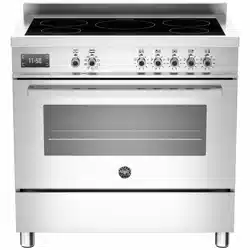Loading ...
Loading ...
Loading ...

17
Power rating (4 zones model)
Zone number:
Power absorption
Diameter
Normal operation:
With power function:
1
2300 W
3700 W
210 mm
2
1850 W
3000 W
180 mm
3
1850 W
3000 W
180 mm
4
1850 W
3000 W
180 mm
Power rating (5 zones model)
Zone number:
Power absorption
Diameter
Normal operation:
With power function:
1
1100 W
1400 W
160 mm
2
1100 W
1400 W
160 mm
3
1400 W
2000 W
200 mm
4
2300 W
3000 W
250 mm
5
2300 W
3000 W
200 mm
When the hob is used for the first time, it should be heated to its maximum
temperature for long enough to bum off any oily residues left by the manufacturing
process, which might contaminate foods with unpleasant smells.
Types of pans This type of appliance can only operate with pans of special kinds.
The bottom of the pan must be iron or steel/iron to generate the magnetic field
necessary for the heating process.
Vessels made from the following materials are not suitable:
glass;
porcelain;
pottery;
steel, aluminium or copper without magnetic bottom;
To check that a pan is suitable, simply place a magnet close to its bottom:
if the magnet is attracted, the pan is suitable for induction cooking. If no magnet is to
hand, put a little water in the pan, place it on a cooking zone and switch it on. If the
symbol appears on the display instead of the power, the pan is not suitable.
The pans used for cooking must have certain minimum diameters to ensure
satisfactory operation.
Pans larger than the cooking zones can also be used, but it is important to ensure
that the bottom of the pan does not touch other cooking zones, and that it is always
centred over the perimeter of the cooking zone (Fig.18A-18B).
Fig 18A Fig 18B
Use only vessels specially designed for induction cooking, with thick, completely flat
bottom; if these are not available, the pans used must not have crowned (concave or
convex) bottom (Fig.19).
Loading ...
Loading ...
Loading ...
